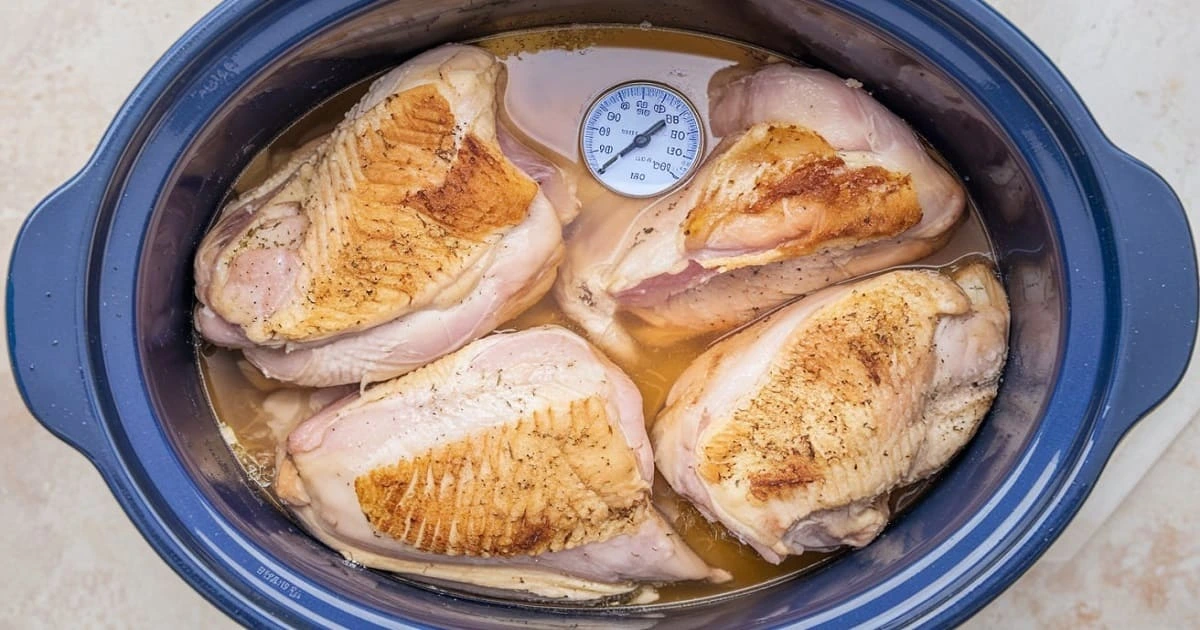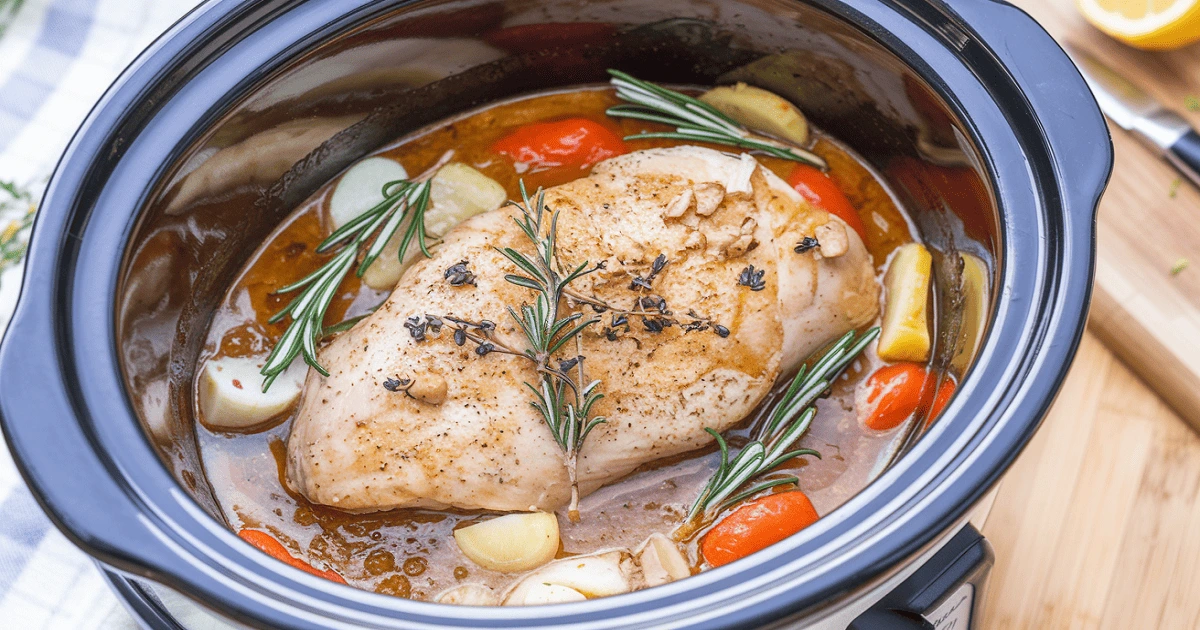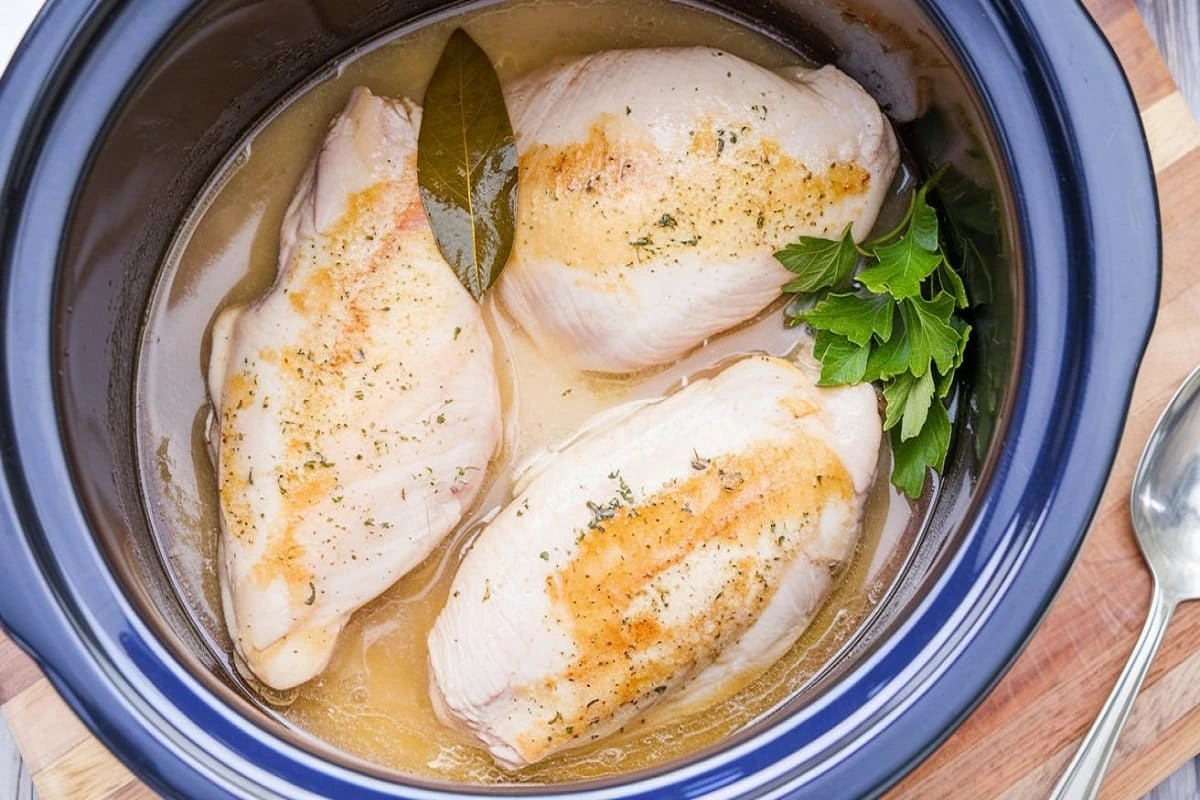Why is my chicken breast tough in the slow cooker? It’s a common frustration for many home cooks. Despite using a slow cooker, which is supposed to make cooking easier, the results can often be dry, chewy, or rubbery chicken breasts. This issue arises when the cooking time, heat setting, or liquid content is not properly managed. Chicken breasts are lean, meaning they lack the fat needed to naturally retain moisture during long cooking.
In this article, we’ll explore the common reasons behind tough chicken breasts in the slow cooker and offer tips to prevent it. Whether you’re slow-cooking chicken for tacos, soups, or meal preps, following these techniques will ensure tender, juicy results every time.
For more ideas on achieving perfect chicken, explore how to keep diced chicken breast moist and juicy bone-in chicken breast recipes on Kinsley Recipes.
The Nature of Chicken Breasts and Why They Get Tough
Chicken breasts are known for being lean and relatively low in fat compared to other cuts, such as thighs or drumsticks. While this makes them a great choice for those seeking a nutritious source of protein, it also makes them prone to drying out when cooked incorrectly.
Why does this happen?
The absence of sufficient fat and connective tissue in chicken breasts limits their ability to retain moisture. In cuts like thighs or drumsticks, the fat and collagen content helps keep the meat moist during cooking, particularly in methods that expose the chicken to prolonged heat, such as slow cooking.
Additionally, chicken breasts are often uneven in thickness, with one side being thicker than the other. This results in uneven cooking, where the thinner parts overcook and dry out while the thicker parts are still undercooked.
How Slow Cookers Work — and Why Your Chicken Breast Might Be Tough
To truly answer the question, “Why is my chicken breast tough in the slow cooker?”, it helps to understand how slow cookers operate.
Slow cookers use steady, low or moderate heat over a long period to break down tough cuts of meat. This method works beautifully for meats rich in connective tissue, like beef chuck or pork shoulder, which become tender after hours of cooking. But chicken breasts are different—they’re lean and lack that connective tissue, meaning they don’t require much time to become tender.
So, why is your chicken breast tough in the slow cooker? When cooked too long, the proteins in the chicken breast contract tightly, forcing out moisture. The result is a dry, chewy texture instead of the tender, juicy meat you expect.
Another reason why chicken breast turns out tough in a slow cooker is insufficient liquid. Without enough broth, water, or sauce, the chicken doesn’t have the moisture it needs to stay soft throughout the cooking process.
Understanding this helps solve the mystery: Why is my chicken breast tough in the slow cooker? It often comes down to cooking time, moisture levels, and the cut of meat used.
Common Causes of Tough Chicken Breasts in a Slow Cooker
Let’s break down some of the common reasons why chicken breasts turn tough when cooked in a slow cooker:
1. Overcooking
The most common culprit is overcooking. Chicken breasts require far less cooking time than tougher cuts of meat. Leaving them in the slow cooker for hours longer than necessary can make them dry and tough. Although slow cookers are designed to cook over extended periods, chicken breasts should be monitored closely.
2. Lack of Liquid
Slow cookers rely on moisture to cook food evenly. Chicken breasts need to be partially submerged in liquid, whether it’s broth, sauce, or water. If there’s not enough liquid, the meat will dry out. Additionally, the absence of a moisture barrier leads to excessive evaporation of the natural juices within the chicken.

3. High Heat Settings
Using the high heat setting on a slow cooker is another common mistake. While it’s tempting to speed up cooking, chicken breasts benefit from low and slow cooking. Higher temperatures cause the proteins in the meat to shrink too quickly, expelling moisture and leading to a tough texture.
4. Overcrowding the Slow Cooker
When you place too much chicken in the slow cooker, it affects the distribution of heat and moisture. Overcrowding leads to uneven cooking, with some pieces cooking faster than others, which can result in tough spots or undercooked sections.
How Long Should You Cook Chicken Breasts in the Crockpot?
One of the most common reasons people ask, “Why is my chicken breast tough in the slow cooker?” is because of incorrect cooking time.
The ideal cooking time for chicken breasts in a crockpot depends on your heat setting and the amount of liquid. Typically, chicken breasts should cook for 2 to 3 hours on low or 1 to 2 hours on high. Cooking beyond this range can cause the meat to dry out.
It’s important to monitor doneness with a meat thermometer. Once the internal temperature hits 165°F (74°C), the chicken is fully cooked and safe to eat. Letting it continue to cook past this point will cause the proteins to tighten, squeezing out moisture and leading to that familiar complaint:
“Why is my chicken breast tough in the slow cooker?”
To avoid this, remove the chicken from the slow cooker as soon as it reaches the proper temperature. This small step makes a big difference in achieving juicy, tender results.
For more expert advice on timing and preparation, explore these tips for cooking juicy slow-cooker chicken.
Does Chicken Get More Tender the Longer You Slow Cook It?
If you’ve ever asked, “Why is my chicken breast tough in the slow cooker?”, you’re not alone—and part of the confusion comes from a common myth.
Many believe that the longer chicken cooks, the more tender it becomes. While this is true for cuts like chicken thighs or meats rich in connective tissue, it’s not the case for chicken breasts.
Chicken breasts are naturally lean, with little fat or connective tissue. They do not benefit from prolonged slow cooking. In fact, leaving them in the slow cooker too long causes the proteins to contract excessively, pushing out vital moisture and resulting in dry, rubbery meat.
So, if you’re wondering why your chicken breast is tough in the slow cooker, the answer often lies in overcooking. Keeping your cook time within a recommended range—usually 2.5 to 4 hours on low—is key to maintaining tenderness.
In short, chicken breasts don’t get more tender with more time. They get drier. And that’s one major reason why chicken breast turns out tough in the slow cooker
How to Avoid Tough Chicken Breasts in the Slow Cooker
Here are several tried-and-true methods to keep your chicken breasts tender and moist when using a slow cooker:
1. Brine the Chicken Breasts Before Cooking
Brining your chicken breasts in a saltwater solution before slow cooking can make a significant difference. Brining helps the chicken retain moisture during cooking, reducing the risk of drying out. To brine chicken breasts, dissolve 1/4 cup of salt in 4 cups of cold water and submerge the chicken for at least 30 minutes to 2 hours before slow cooking.
Brining also adds flavor to the chicken, ensuring each bite is juicy and seasoned.
2. Add Enough Liquid
Slow cookers depend on moisture, so it’s important to use enough liquid to surround the chicken breasts. Broth, sauces, or water work well to keep the chicken from drying out. Make sure the liquid reaches at least halfway up the chicken breasts. This keeps the chicken moist throughout the cooking process and also enhances flavor.
3. Use Low Heat Settings
While it’s tempting to use the high setting to speed up the cooking process, using low heat is the better option for chicken breasts. Cooking them on low heat for 2-3 hours ensures the meat stays tender and moist without becoming dry.
4. Monitor Cooking Time and Use a Meat Thermometer
Check the internal temperature of your chicken regularly. The key is to remove the chicken as soon as it reaches 165°F (74°C). Overcooking, even by a small amount, will result in tough meat.

5. Avoid Overcrowding the Pot
Make sure to give each piece of chicken enough room in the slow cooker. Overcrowding leads to uneven cooking, with some pieces cooking faster than others, increasing the chances of some chicken turning out tough.
Step-by-Step Guide: Cooking Chicken Breasts in a Slow Cooker
Here’s a simple guide to ensure tender and juicy chicken breasts every time:
Ingredients:
- 2-3 boneless, skinless chicken breasts
- 1 cup chicken broth or sauce of your choice
- Salt and pepper to taste
- Optional: garlic, onions, or herbs for added flavor
Instructions:
- Brine the Chicken:
Dissolve 1/4 cup salt in 4 cups cold water. Submerge the chicken breasts for 30 minutes to 2 hours. - Prepare the Slow Cooker:
Add chicken broth or sauce to the bottom of the slow cooker. Place the chicken breasts in a single layer. - Set the Slow Cooker to Low:
Cook on low heat for 2-3 hours. Check the internal temperature after 2 hours. - Check for Doneness:
Remove the chicken as soon as it reaches 165°F (74°C) to prevent overcooking. - Rest the Chicken:
Allow the chicken to rest for 5-10 minutes before slicing. This helps the juices redistribute throughout the meat.
FAQs: Addressing Common Questions about Tough Chicken Breasts
1. Does Chicken Get More Tender the Longer You Cook It?
No. Chicken breasts tend to become dry and tough with prolonged cooking times, unlike tougher cuts of meat that benefit from long cooking.
2. How Long Does It Take for Chicken Breasts to Get Tender in the Crockpot?
Boneless chicken breasts typically take 2-3 hours on low or 1-2 hours on high to become tender in a slow cooker. Using a meat thermometer is crucial for ensuring the chicken is not overcooked.

3. Why Is Chicken Tough in a Slow Cooker?
Chicken breasts often turn tough in a slow cooker due to overcooking, insufficient liquid, or cooking on high heat. Monitoring the cooking time and temperature is key to preventing this.
4. How Do You Cook Chicken Breasts So They Aren’t Tough?
To avoid tough chicken, brine the meat before cooking, use plenty of liquid, set the slow cooker to low heat, and monitor the internal temperature.
Conclusion: Perfecting Tender and Juicy Chicken Breasts in the Slow Cooker
Wondering why your chicken breast is tough in the slow cooker? Achieving perfectly tender and juicy results comes down to a few essential techniques.
First, avoid overcooking. Chicken breasts lack the connective tissue and fat found in thighs, which makes them prone to drying out. Leaving them too long in the slow cooker is a common reason why your chicken breast might be tough in the slow cooker.
Choosing low heat settings instead of high ensures the chicken cooks gently, keeping the proteins from tightening too quickly and pushing out moisture.
Another reason why chicken breast turns tough in the slow cooker is insufficient liquid. Whether you use broth, water, or sauce, the liquid acts as a moisture barrier that protects the meat’s texture. Be sure the chicken is at least partially submerged during cooking.
Brining beforehand is another effective method. Brining helps lock in moisture so that even after slow cooking, the chicken stays tender and flavorful.
A meat thermometer is your best friend—if you’ve ever asked “why is my chicken breast tough in the slow cooker,” it may be because it’s overcooked. Remove it once it reaches an internal temperature of 165°F (74°C).
By combining these tips—brining, cooking on low, adding sufficient liquid, and monitoring temperature—you can stop asking, “Why is my chicken breast tough in the slow cooker?” and start enjoying perfect, juicy results every time. Don’t forget to let the chicken rest after cooking to allow juices to redistribute evenly.
For more cooking inspiration, explore slow cooker chicken breast recipes.


Woh I like your content, saved to bookmarks! .
Unquestionably believe that which you stated. Your favorite reason appeared to be on the net the easiest thing to be aware of. I say to you, I definitely get annoyed while people consider worries that they just do not know about. You managed to hit the nail upon the top and defined out the whole thing without having side-effects , people could take a signal. Will likely be back to get more. Thanks